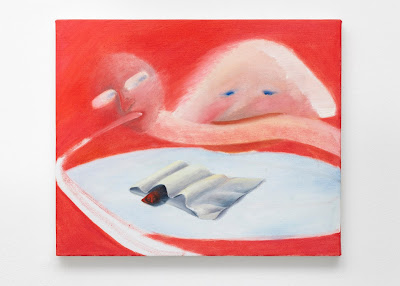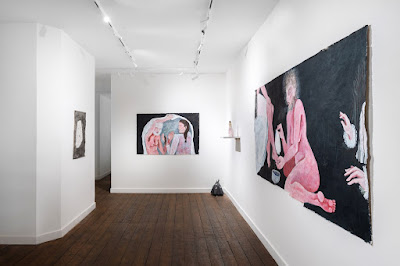Fertile Spoon at Bosse & Baum
In England, galleries were permitted to open again on 12 April after months of pandemic-induced closure. In that time, many of us had been checking out art predominantly through Instagram and (the now-dreaded) online viewing rooms. I had been to a couple of other shows in the days before heading to Peckham's Bosse & Baum, but hadn't had my interest set alight just yet. But I was glad to finally be awoken from my screen-addled slumber, as 'Fertile Spoon' was the "welcome back!" I had been craving. The doors were flung open and the sunshine was pouring in as I entered the space after making my booking online, and I was instantly pleased to be seeing art among other people.
'Fertile Spoon' is a two-person exhibition between contemporary artist Mary Stephenson, who is currently studying at the Royal Academy Schools, and Grace Pailthorpe, a twentieth-century doctor, surgeon, psychoanalyst and painter. From this pitch alone, I was sold. In terms of effective exhibition-making, having two artists in some form of dialogue is usually the best way of weaving a story, whether the focus is on a thread running between the artists' work or simply that the two complement each other. For Stephenson and Pailthorpe, it is both, with strong psychoanalytical motifs and dream-like aesthetics and tones radiating throughout. The gallery itself has also been punctuated with accent blocks on particular walls. With Pailthorpe's work on loan for the show, there is certainly a museum quality to 'Fertile Spoon', and it is clear that a great deal of research has gone into the pairing.
One particularly interesting element of both artists' work is that neither feel especially grounded in one moment in time. Stephenson's work could have easily been produced in the twentieth century, especially the smaller works such as 'Napkin', pictured above, and my personal favourite, 'White Linens II', (which I couldn't stop thinking about long after leaving the gallery) and similarly if Pailthorpe was being touted as an emerging artist in 2021, you'd certainly believe it. I truly appreciated the ways in which the artists are similar in their subject matter, in a somewhat abstract way, whilst at the same time their painting styles are so different. The bold, deep blues in Stephenson's work are engulfing in her larger pieces; that they are depicting vast bodies of water is entrancing, perhaps amplified by the fact that, as a city girl, I have not been near the ocean for a long time. It is hard to convey the richness of the works through photographic documentation, as I found while I was there, as I so desperately wanted to capture the feeling the paintings, particularly 'Untitled' from 2020, were evoking for me.
Psychoanalysis as a recurring theme is a welcome one at a time where mental health is increasingly becoming an inescapable priority. 'Untitled', pictured above, is perhaps the most startlingly emotive on the subject. While the blues are swirling, active and beautiful, the individual faces and expressions held by the painting's three figures are haunting, conveying a potential sense of severe pain and trauma. We see abandonment, shame and mourning, all implied but not explicitly reproduced. This is a stunning form of storytelling through painting, one that feels all the more special as we experience a 'post-scarcity culture', whereby in the West we have no shortage of shallow, quick-fix information and (to an extent) resources, with ever-decreasing value due to their availability. Vast expanses of watery space fused with human bodies imbued with trauma and pain, in the large scale of 180cm x 150cm, make for a truly arresting experience, one that is simply not possible through a screen.







